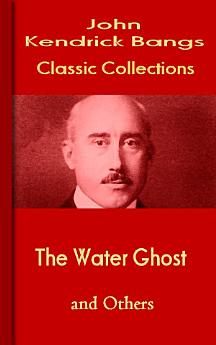The Water Ghost and Others: Bangs Classic Collection
About this ebook
For the purposes of this bit of history, Bangletop Hall stands upon a grassy knoll on the left bank of the River Dee, about eighteen miles from the quaint old city of Chester. It does not in reality stand there, nor has it ever done so, but consideration for the interests of the living compels me to conceal its exact location, and so to befog the public as to its whereabouts that its identity may never be revealed to its disadvantage. It is a rentable property, and were it known that it has had a mystery connected with it of so deep, dark, and eerie a nature as that about to be related, I fear that its usefulness, save as an accessory to romance, would be seriously impaired, and that as an investment it would become practically worthless.
The hall is a fair specimen of the architecture which prevailed at the time of Edward the Confessor; that is to say, the main portion of the structure, erected in Edward's time by the first Baron Bangletop, has that square, substantial, stony aspect which to the eye versed in architecture identifies it at once as a product of that enlightened era. Later owners, the successive Barons Bangletop, have added to its original dimensions, putting Queen Anne wings here, Elizabethan ells there, and an Italian-Renaissance facade on the river front. A Wisconsin water tower, connected with the main building by a low Gothic alleyway, stands to the south; while toward the east is a Greek chapel, used by the present occupant as a store-room for his wife's trunks, she having lately returned from Paris with a wardrobe calculated to last through the first half of the coming London season. Altogether Bangletop Hall is an impressive structure, and at first sight gives rise to various emotions in the aesthetic breast; some cavil, others admire. One leading architect of Berlin travelled all the way from his German home to Bangletop Hall to show that famous structure to his son, a student in the profession which his father adorned; to whom he is said to have observed that...
Ratings and reviews
About the author
He was born in Yonkers, New York. His father Francis Nehemiah Bangs was a lawyer in New York City, as was his brother, Francis S. Bangs.
He went to Columbia University from 1880 to 1883 where he became editor of Columbia's literary magazine and contributed short anonymous pieces to humor magazines. After graduation in 1883, Bangs entered Columbia Law School but left in 1884 to become Associate Editor of Life under Edward S. Martin. Bangs contributed many articles and poems to the magazine between 1884 and 1888. During this period, Bangs published his first books.
In 1888 Bangs left Life to work at Harper's Magazine, Harper's Bazaar and Harper's Young People. From 1889 to 1900 he held the title of Editor of the Departments of Humor for all three Harper's magazines and from 1899 to 1901 served as active editor of Harper's Weekly. Bangs also served for a short time (January–June 1889) as the first editor of Munsey's Magazine and became editor of the American edition of the Harper-owned Literature from January to November 1899.
He left Harper & Brothers in 1901 and became editor of the New Metropolitan magazine in 1903. In 1904 he was appointed editor of Puck, perhaps the foremost American humor magazine of its day. In this period, he revived his earlier interest in drama. In 1906 he switched his focus to the lecture circuit.
During the period between 1901 & 1906, Mr. Bangs was known to have spent at least parts of his summers at the Profile House in Franconia, New Hampshire. He owned one of the 20 connected cottages adjacent to the large hotel, which he sold to Cornelius Newton Bliss in August of 1906. As a satirical writer, he was also known in the "Profile Cottage" circles as a jokester and prankster and was frequently the jovial topic of hotel guests and cottage owners alike.
Agnes Hyde Bangs, his wife with whom he had three sons, died in 1903. Bangs then married Mary Gray. In 1907 they moved from Yonkers to Ogunquit, Maine. John Kendrick Bangs died from stomach cancer in 1922 at age fifty-nine, in Atlantic City, New Jersey.











